Dental Investments And Refractory Materials Notes
A refractory is a nonmetallic material that can withstand high temperatures without degrading, softening, or losing its strength.
An investment can be described as a ceramic material that is suitable for forming a mold into which molten metal or alloy is cast.
- The procedure for forming the mold is described as ‘investing’. These materials can withstand high temperatures.
- For this reason, they are also known as refractory materials. Investment materials are covered by ISO 15912:2006.
- This standard also covers, brazing investments and refractory die materials.
Read And Learn More: Basic Dental Materials Notes
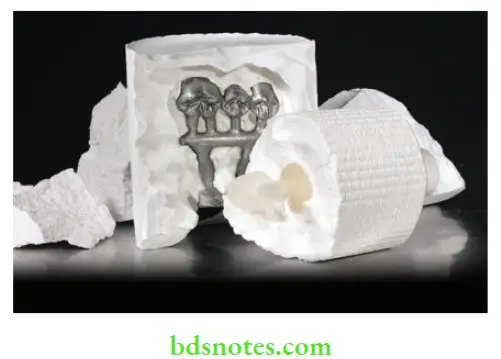
Requirements Of An Investment Material
The investment mold must expand to compensate for the alloy shrinkage, which occurs during the cooling of the molten alloy. The powder should have a fine particle size to give a smooth surface to the casting.
- The manipulation should be easy. It should have a suitable setting time.
- The material should have a smooth consistency when mixed.
- The set material should be porous enough to permit air in the mold cavity to escape easily during casting.
- At higher temperatures, the investment must not decompose to give of gases that may corrode the surface of the alloy.
- It must have adequate strength at room temperature to permit handling, and enough strength at higher temperatures to withstand the impact force of the molten metal
- Casting temperatures should not be critical.
- After casting, it should break away readily from the surface of the metal and should not react chemically with it.
- The material should be economical.
Classification Of Refractory Materials In Dentistry
The classification covers all refractory materials in dentistry including casting investments, brazing investments, and refractory dies.
Classification based on application (ISO 15912:2006)
- Type 1: for the construction of inlays, crowns, and other field restorations
- Type 2: for the construction of complete or partial dentures or other removable appliances
- Type 3: for the construction of casts used in brazing procedures
- Type 4: for the construction of refractory dies
Sub-classification based on the method of burnout (ISO 15912:2006)
- Class 1: Recommended for burn-out by a slow- or step-heating method
- Class 2: Recommended for burn-out by a quick-heating method
Classification based on the type of binder used There are three types of investment materials based on the binder used. They all contain silica as the refractory material. The type of binder used is different.
- Gypsum bonded investments They are used for casting gold alloys. They can withstand temperatures up to 700 °C.
- Phosphate bonded investments For metal ceramic and cobalt-chromium alloys. They can withstand higher temperatures.
- Ethyl silica bonded investments They are an alternative to phosphate bonded investments, for high-temperature casting. They are principally used in the casting of base metal alloy partial dentures.
General Composition Of Investments
All investment materials contain a refractory, a binder, and modifications.
Refractory A refractory is a material that will withstand high temperatures without decomposing or disintegrating, for example, silica.
Allotropic forms Silica exists in at least four allotropic forms.
- Quartz
- Tridymite
- Cristobalite
- Fused quartz
They serve two functions
- Act as a material that can withstand high temperatures.
- Regulate the thermal expansion.
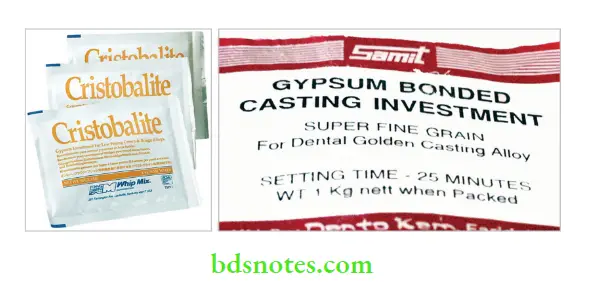
Binder
- A material that will set and bind together the particles of a refractory substance, for example, gypsum, phosphate, and silicate.
- The common binder used for gold alloys is dental stone (alpha hemihydrate).
- The investments for casting cobalt-chromium alloys use ethyl silicate, ammonium sulfate, or sodium phosphate.
Chemical Modifiers
Chemicals such as sodium chloride, boric acid, potassium sulfate, graphite, copper powder, or magnesium oxide are added in small quantities to modify properties.
Gypsum Bonded Investments
Classification
- The ISO (15912:2006) classification for refractory materials applies to gypsum-bonded investments and phosphate-bonded investments.
- Thus, there are four types based on application—Type 1, 2, 3, and 4 and two subclasses—Class 1 and 2 based on the method of burnout. (See ISO classification at the beginning of the chapter for details).
Gypsum Uses
For the casting of inlays, fixed partial dentures, and removable partial denture frameworks using gold alloys, and other low-fusing alloys.
Gypsum Supplied as
- Powder in bulk or preweighed packs.
- Representative commercial products Cristobalite, Novocast (Whipmix), etc.
Gypsum Composition

Functions Of Constituents
Alpha hemihydrate
- It binds and holds the silica particles together.
- Permits pouring of the mix into the mold.
- It imparts strength to the mold.
- Contributes to mold expansion (by setting expansion).
Silica quartz or cristobalite
- Acts as a refractory during heating.
- Regulates thermal expansion.
- Increases setting expansion of stone.
- Silica in the investment eliminates the contraction of gypsum and changes it to an expansion during heating.
Modifiers
Coloring matter
- Reducing agents: They reduce any oxides formed on the metal by providing a nonoxidizing atmosphere in the mold when the mold alloy enters, for example, carbon or copper powder.
- Modifying chemicals: They regulate setting expansion and setting time and also prevent shrinkage of gypsum when heated above 300 °C, e.g. boric acid and sodium chloride.
Manipulation
The measured quantity of powder and water is mixed manually using a flexible rubber bowl and spatula or in a vacuum investment mixing machine.
Setting Reaction
The setting reaction is similar to dental stone. When the water is mixed, the hemihydrate reacts to form dihydrate which sets to form a solid mass that binds the silica particles together.
Setting Time
- According to AdA Sp. No. 2 For inlay investments, setting time should not be less than 5 minutes and not more than 25 minutes.
- The modern inlay investments are set initially in 9 to 18 minutes. This provides sufficient time for mixing and investing in the pattern.
Factors controlling setting time
- Manufacturing process
- Mixing time and rate
- Water-powder ratio
- Temperature
- Modifiers—accelerators and retarders
Properties Of Gypsum Investments
Thermal Behavior Of Gypsum
- When gypsum is heated to a high temperature, it shrinks and fractures. At 700 °C, it shows slight expansion and then a great amount of contraction.
- The shrinkage is due to decomposition and the release of sulfur dioxide.
- It contaminates the casting with the sulfides of silver and copper.
- So the gypsum bonded investments should not be heated above 700 °C.
Thermal Behavior Of Silica
When heated, quartz or cristobalite changes its crystalline form. This occurs at a transition temperature, characteristic of the particular form of silica.
- Quartz when heated, inverts from a ‘low’ form known as alpha-quartz to a ‘high’ form called beta-quartz at a temperature of 375 °C.
- Cristobalite similarly when heated, inverts from ‘low’ or alpha-cristobalite to ‘high’ or beta-cristobalite at a temperature between 200 °C and 270 °C.
- The beta forms are stable only above the transition temperature.
- It changes back to the low or alpha form that occurs upon cooling in each case.
- The density changes (decreases) as alpha form changes to beta-form, with a resulting increase in volume and a rapid increase in linear expansion.
Expansion
Expansion aids in enlarging the mold to compensate for the casting shrinkage of the gold alloys.
Three types of expansions may be seen
- Normal setting expansion
- Hygroscopic setting expansion
- Thermal expansion
Normal setting expansion
- A mixture of silica and dental stone results in a setting expansion that is greater than when the gypsum product is used alone.
- The silica particles probably interfere with the intermeshing of the crystals as they form. Thus, the thrust of the crystals is outward during growth.
- AdA Sp. No. 2 for Type-I investment permits a maximum setting expansion in the air of 0.5%.
- Modern investments show a setting expansion of 0.4%. It is regulated by retarders and accelerators.
Hygroscopic setting expansion (HSE)
- When gypsum products are allowed to be set in contact with water, the amount of expansion exhibited is much greater than the normal setting expansion.
- The increased amount of expansion is because water helps the outward growth of crystals.
- This expansion is known as hygroscopic setting expansion.
- The investment should be immersed in water before the initial set is complete.
- AdA Sp. No. 2 for Type-II investments requires a minimal 1.2% and maximum 2.2% expansion.
- Factors affecting hygroscopic setting expansionComposition The faster the particle size of the silica, the greater the HSE. Alphahemihydrate produces a greater expansion than beta-hemihydrate. The higher the silica content the greater the expansion.
- W-P ratio The higher the W-P ratio of the original investment water mixture, the less the HSE.
- Temperature Higher the temperature of the immersion water, the less the surface tension, and hence, the greater the expansion.
- Effect of time of immersion Immersion before the initial set results in greater expansion.
- Speculation Shorter the mixing time, the less the HSE.
- Effect of shelf-life of the investment The older the investment, the less is hygroscopic expansion.
- Confinement of the investment by the walls of the container or the wax pattern reduces HSE. This effect is much more pronounced on the HSE than on the normal setting expansion.
- Effect of the amount of added water The More amount of water added during the setting period, the more is the expansion.
Thermal expansion
- In the case of gypsum investments, thermal expansion (TE) is achieved by placing the mold in a furnace at a temperature not greater than 700 °C (the investment breaks down if it exceeds this temperature releasing gases that can contaminate the gold alloys).
- The thermal expansion behavior of one investment is shown in.
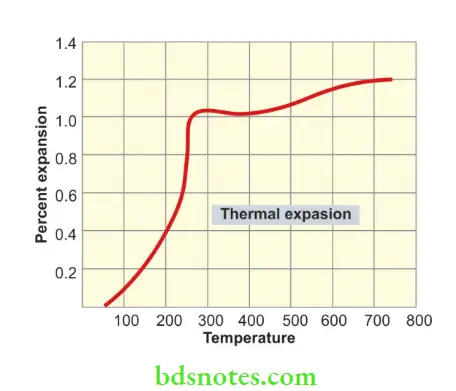
- The amount of thermal expansion required depends on which method is used for casting shrinkage compensation.
- If the hygroscopic expansion technique is used, then TE of 0.5 to 0.6% is sufficient.
- But if the compensation is by TE together with the normal setting expansion, then the TE should be 1 to 2%.
- Type-1 investments should have a TE not less than 1 nor greater than 1.6%.
Factors affecting thermal expansion
- TE is related to the amount and type of silica used.
- The effect of the W-P ratio more the water, less the TE.
- Effect of chemical modifiers Small amounts of sodium chloride, potassium chloride, and lithium chloride increase TE and eliminate the contraction caused by gypsum.
Strength
According to ISO 15912:2006, the compressive strength for investments should not be less than 2 MPa when tested 2 hours after setting.
Factors affecting strength
- Use of alpha-hemihydrate increases compressive strength (than beta-hemihydrate).
- The use of chemical modifiers increases the strength.
- The more water used during mixing, the less is strength.
- Heating the investment to 700 °C may increase or decrease strength as much as 65% depending on the composition. The greatest reduction in strength upon heating is found in investments containing sodium chloride.
- After the investment has cooled to room temperature, its strength decreases considerably because of fie cracks that form during cooling.
Porosity
- The more gypsum crystals present in the set investment, the less is its porosity.
- The less the hemihydrate content and the greater the amount of gauging water, the more is its porosity.
- A mixture of coarse and fine particles exhibits less porosity than an investment composed of uniform particle size (a certain amount of porosity is essential in the mold in order to allow the escape of gases during casting).
Fineness
A fine particle size is preferable to a coarse one. The faster the investment, the smaller will be the surface irregularities on the casting.
Storage
Investments should be stored in airtight and moisture-proof containers. Purchase in small quantities.
Hygroscopic Thermal Inlay Casting Investment
- An investment that can be used as a hygroscopic or thermal type is available (for example Beauty cast – Whipmix). The investment contains a blend of quartz and cristobalite as the refractory.
- For the hygroscopic expansion technique, the investment is heated only up to 482 °C. When the thermal casting technique is used the investment (is not immersed in water but) is heated to 649 °C to achieve expansion.
Investments For Casting High Melting Alloys
- The metal-ceramic alloys and the cobalt-chromium alloys have high melting temperatures.
- They are cast in molds at 850 to 1100 °C. At these temperatures, the gypsum-bonded investments disintegrate.
- Hence, investments that can withstand higher temperatures are required.
- The binders used (phosphate and silicate) in these investments can withstand these high temperatures.
The investments used for this purpose are
- Phosphate bonded investments
- Silica bonded investments
- Magnesia/alumina/zirconia-based investments for titanium
Phosphate Bonded Investment
Phosphate-bonded investments are perhaps the most widely utilized investment in dentistry.
This is because a substantial amount of cast dental structures today use high-fusing noble or base metal alloys.
Phosphate Uses
For casting high-fusing alloys, for example, high-fusing noble metal alloys, metal-ceramic alloys, and base metal alloys like nickel-chromium and cobalt-chromium.
Phosphate Classification
- The ISO (15912:2006) classification for refractory materials applies to phosphate-bonded investments also.
- Thus, there are four types based on application—Type 1, 2, 3, and 4 and two subclasses—Class 1 and 2 based on the method of burnout.
Phosphate Supplied as
Powder in packets of varying weight with a special liquid.
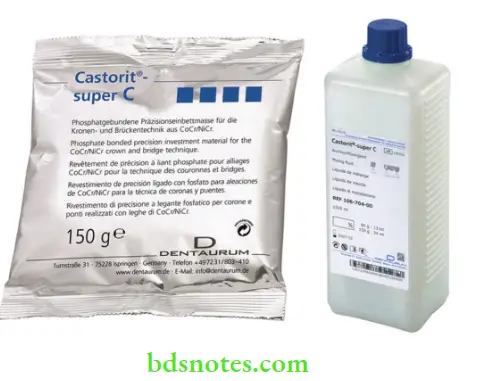
Phosphate Composition
Powder
Ammonium diacid phosphate NH4H2PO4
- It gives strength at room temperature.
- It is soluble in water and provides phosphate ions.
- It reacts with silica at high temperatures to increase strength at casting temperatures.
- Silica in the form of quartz or cristobalite (80%) functions as refractory. Magnesium oxide Reacts with phosphate ions.
- Carbon Some investments contain carbon while others are carbon-free.
- Carbon helps to produce clean castings and helps in easier divestment from mold.
- For non-compatible alloys carbon free investments are preferred.
Liquid
- The phosphate-bonded investments are mixed with a special liquid supplied by the manufacturer.
- This liquid is a form of silica sol in water, which gives higher thermal expansion.
Setting Reaction
- At room temperature ammonium diacid phosphate reacts with magnesium oxide to give the investment green strength or room temperature strength.
- NH4H 2PO4+ MgO + 5H2O → NH4MgPO4.H2O
- The ammonium diacid phosphate is used in a greater amount than is necessary for this reaction so that the additional amount can react with silica at an elevated temperature.
- At higher temperatures, there is probably a superficial reaction between P2O5 and SiO2 to form silicophosphate, which increases the strength of investment at a higher temperatures.
Manipulation
- Powder/liquid ratio – 16 to 23 ml/100 gm.
- (The liquid is usually diluted with water.
- The amount of liquid to water ratio varies with the particular brand of investment and type of alloy used.
- The amount of water used ranges from 0 to 50 depending on the expansion required).
- The powder is mixed with a measured amount of liquid using a bowl and spatula.
- Following hand mixing for 20 seconds mechanical mixing under vacuum is done for a further 90 seconds.
- Working time is around 8-9 minutes. The mixed material is vibrated into the casting ring or agar mold (RPd framework).
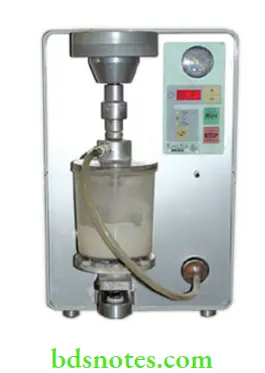
- The material is allowed to be bench set for a minimum of 30-45 minutes depending on the particular investment.
- Following this, the glaze on top of the investment is scraped to allow air escape and reduce back pressure porosity during casting.
Factors affecting setting time
- The temperature of the mix and environment. Warmer temperatures accelerate the setting. Cooling the liquid prolongs the working time.
- Increasing the mixing time accelerates the set.
- An increased L-P ratio delays setting and gives more working time.
Properties
Expansion
As mentioned earlier, expansion of the mold is desirable to compensate for casting shrinkage. Phosphate investments get their expansion from three sources.
- Wax pattern expansion: The heat during setting allows a significant expansion of the wax pattern.
- Setting expansion: This is around 0.7 to 1%.
- Thermal expansion: Ranges from around 1 to 1.5%.
The amount of expansion is adjusted by the manufacturer for each product depending on the alloy it is intended for.
Factors affecting expansion
- Special liquid-to-water ratio The liquid has a considerable influence on the setting and thermal expansion of the investment. The greater the concentration of special liquid to water, the greater the thermal and setting expansions.
- Powder-to-liquid ratio A greater powder-to-liquid ratio increases expansion.
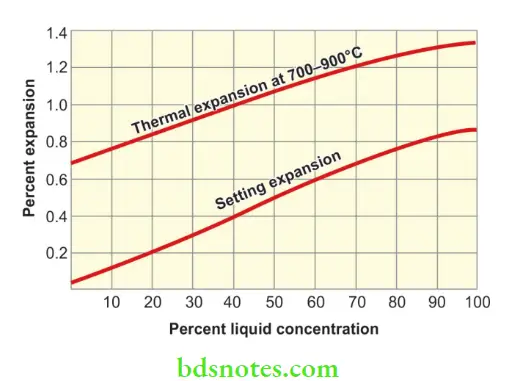
Strength
- Regular investments are generally materials of low strength.
- Wet strength ranges from 4–10 MPa. Wet strength is important for handling the set material prior to casting.
- Dry strength is the strength of the investment under high temperatures.
- The investment should have sufficient strength to withstand the casting force of the molten alloy at high temperatures.
- Studies have shown that there is no correlation between the wet and dry strength of phosphate-bonded investments.
- One study indicates that investments exhibit plastic behavior at high temperatures which, under casting pressure, maybe a source of inaccurate casting, a hitherto unrecognized source of error.
Thermal reactions
- Phosphate-bonded investments undergo thermochemical reactions when heated to high temperatures.
- The silica portion remains essentially unchanged. However, the binder goes through various phases.
- On heating, the material initially dehydrates to (NH4MgPO4.H2O) n.
- Subsequently, it degrades into polymeric (Mg2P2O7)n, crystalline Mg 2P2O7; then the latter reacts with excess MgO present to form the final product, Mg 3(PO4) 2.
Flow
- Investments appear to have low flow when mixed.
- However, they flow readily and envelope the pattern when poured into the mold under vibration.
- Therefore, the use of a vibrator is recommended.
- Surface tension-reducing agents are available and should be used on the wax pattern to improve wetting.
Surface smoothness
- Early phosphate investments produced rough castings when compared to gypsum-based investments.
- Current investments have improved and now approach surface smoothness comparable to that of gypsum-bonded investments.
Specialized Refractory Materials
Phosphate Bonded Refractory Casts For Rpds
- A refractory cast is a special cast made from a heat-resistant (investment) material.
- Such casts are used in the fabrication of certain large metal structures like cast removable partial dentures.
- Small wax structures like inlays, crowns, and small fixed dental prostheses (FdP) can be constructed on a regular die as it can be removed from the die without significant distortion and invested separately.
- However, larger wax structures like that for the cast RPd would distort if removed from the cast.
- RPd patterns are best constructed on a refractory cast. The pattern is invested together with the refractory cast.
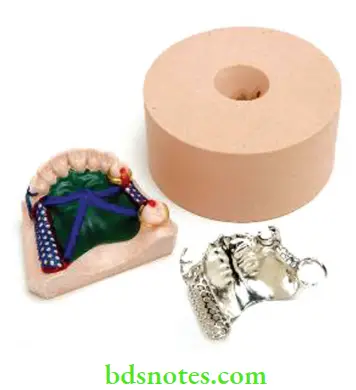
Investments For Ceramics
Phosphate-based investments are also available for ceramic restorations (for example Polyvest and VHT – Whipmix,).
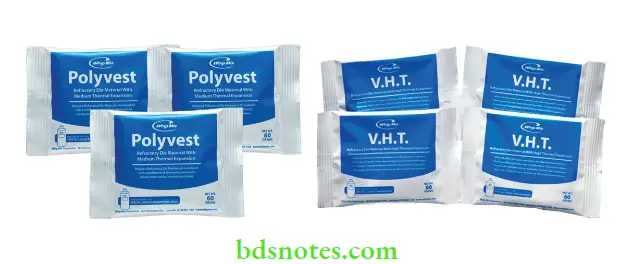
Ceramics Types
Two types are available
- Those used as refractory dies or casts to construct all-porcelain restorations like porcelain veneers and porcelain jacket crowns (ISO 11245). Two varieties are seen based on expansion.
- Medium expansion—Originally used for the cast glass technique. Currently used with medium expanding porcelains like Finesse, Ceramco Veneer, duceram (Dentsply), Vita-VMK 68, Halo (3M), Noritake EX 3, etc. Example Polyvest.
- High expansion—The second type is used with high expansion porcelains like OptecHSP/VP (Jeneric/Pentron Inc.), Wil-Ceram (Williams Dental Co.), Excelco (Ney), and Creation (Jensen).
- The second type is used with heat-pressed ceramics. It is not used as a
die, rather, it is used to surround the wax pattern for the heat-pressing process.
Ceramics Properties
- These are fine-grained phosphate investments with a working time of 2–5 minutes.
- Unlike regular refractory materials, these can withstand repeated firings at furnace temperatures of up to 1200 °C without disintegrating.
- They can be used with high-expanding porcelains because of their compatible CTEs.
Investments in titanium Castings
Conventional silica (SiO2) based dental casting investments are used for the casting of pure titanium using casting machines specifically developed for this metal.
Highly reactive molten titanium reduces SiO2 and titanium is, in turn, oxidized.
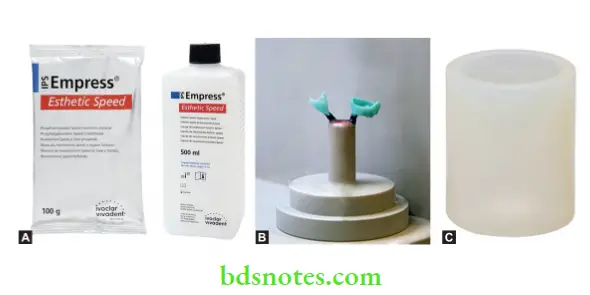
- (A) Phosphate bonded investment for heat-pressed ceramics.
- (B) Wax pattern attached to sprue former.
- (C) Wax pattern is placed inside the silicone mold former into which the investment is poured.
- For this reason, possible alternatives to SiO2 have been studied in the past decade and MgO (magnesia) and
- Al2O3(alumina) is the most common in current commercial investments released for titanium casting.
- The surface of titanium castings presents a layered structure and its evaluation in relation to clinical performance requires further study, especially in relation to the setting and thermal behavior of newly developed investments for successful compensation of metal shrinkage.
Silica Bonded Investments
The silica is the binder. It is derived from ethyl silicate or aqueous dispersion of colloidal silica or sodium silicate. These are less commonly used.
Silica Types
- Based on the binder used two types may be seen.
- One such investment consists of silica refractory, which is bonded by the hydrolysis of ethyl silicate in the presence of hydrochloric acid.
- The product of the hydrolysis is the formation of a colloidal solution of silicic acid and ethyl alcohol.
⇒ \(\mathrm{Si}\left(\mathrm{OC}_2 \mathrm{H}_5\right)_4+4 \mathrm{H}_2\) \(\underrightarrow{\mathrm{HCl}}\) \(\mathrm{Si}(\mathrm{OH})_4+4 \mathrm{C}_2 \mathrm{H}_5 \mathrm{OH}\)
- Ethyl silicate has the disadvantage of containing inflammable components which are required for manufacture.
- Sodium silicate and colloidal silica are more commonly used as binders because of the above disadvantage.
- These investments are supplied along with two bottles of special liquid.
- One bottle contains dilute water-soluble silicate solution such as sodium silicate.
- The other bottle usually contains diluted acid solution such as hydrochloric acid.
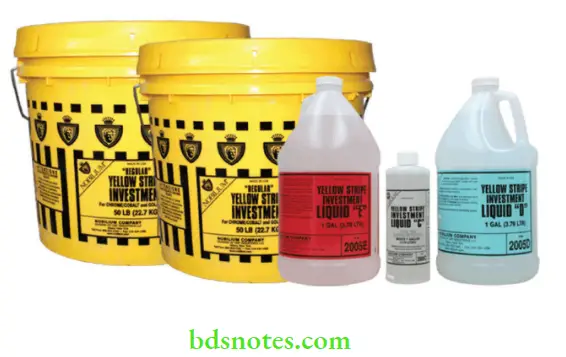
Silica Manipulation
- The content of each bottle can be stored indefinitely.
- Before use, an equal volume of each bottle is mixed so that hydrolysis can take place and freshly prepared silicic acid is formed.
- The powder/liquid ratio is according to the manufacturer’s instructions.
Brazing Investment
In the process of assembling the parts of a restoration by soldering, such as clasps on a removable partial denture, it is necessary to surround the parts with a suitable ceramic or investment
Brazing Uses
- Joining segments of fixed partial dentures.
- Fixing clasps on cast RPds.
- Attaching precision attachments.
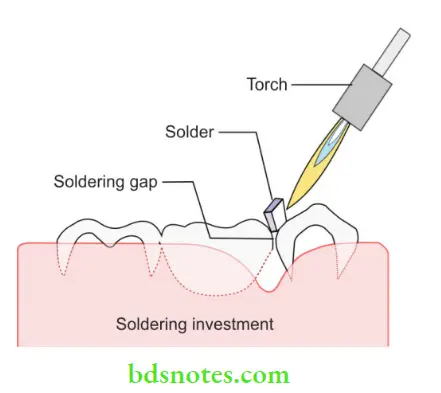
Brazing Types
Based on the type of binder used brazing investments are of two types.
- Gypsum-bonded (for low melting alloys, for example, Hi-Heat, Whipmix, etc.)
- Phosphate-bonded (for high melting alloys), for example, Bellatherm (Bego).
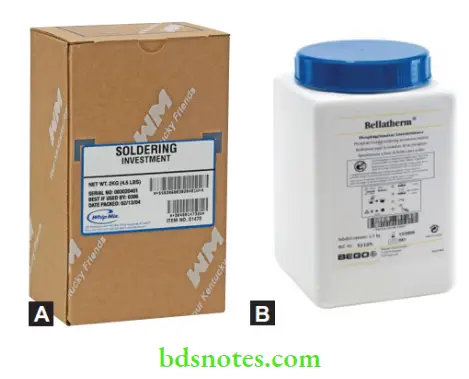
- (A) Gypsum bonded.
- (B) Phosphate bonded.
Brazing Composition
The investment for soldering purposes is similar to casting investments containing quartz and a calcium sulfate hemihydrate/or phosphate binder.
Brazing Properties
- Soldering investments are designed to have lower settings (0.2%) and thermal expansions (0.6–1%) than casting investments, a feature that is desirable so that the assembled parts do not shift position.
- Soldering investments do not have as fine a particle size as the casting investment, since the smoothness of the mass is less important.
- The compressive strength is generally low (between 2 to 10 MPa).
- Water-powder ratio ranges from 0.24 to 0.28. Setting time ranges from 15 to 20 minutes.
Brazing Procedure
- The parts are temporarily held together with sticky wax until they are surrounded with the appropriate investment material, after which the wax is removed.
- The portion to be soldered is left exposed and free from investment to permit removal of the wax and effective heating before being joined with solder.
- After setting, the material must be completely dry before soldering. Recommended drying temperature varies between 400 to 450 °C.

Leave a Reply